Emily. She/her. Early 30s. Deep Space Nine is eating my brain and it could be eating yours too.
Last active 60 minutes ago
Don't wanna be here? Send us removal request.
Note
cutest shark facts?


Nurse sharks and white tip reef sharks form a pile and cuddle!
It's believed to be a form of social bonding and has helped challenge the "lone shark" assumption, allowing us to learn more about shark ecology and interaction!
3K notes
·
View notes
Text
Sometimes being in environmental law means that your schedule for the afternoon gets completely thrown because a colleague standing the middle of some woods calls to tell you that there’s gunk in the stream and it smells bad.
184 notes
·
View notes
Text
Antisemitism IS Being Weaponized (Against Non-Jews)
[Non-Jews are invited and encouraged to reblog this post]
It's absolutely true that non-Jews are being manipulated by weaponized antisemitism.
Antisemitism isn’t just an old hatred. it’s a reliable tool used to manipulate people, to keep them angry at the wrong things, to ensure they are distracted from real threats, to consolidate power or unite the gullible against a common enemy.
The following are just a handful of the many examples in which those in power used Jews and/or antisemitism to manipulate non-Jews and protect their own power.
If you want to understand how deceptive political narratives are crafted today, you need to recognize the old tricks.
Ancient Rome (1st Century CE): Make an Example of the Weirdos
After the Jewish revolt against Roman rule, the empire crushed the rebellion and destroyed the Second Temple in Jerusalem, but the Roman victory wasn’t complete until they won the PR battle. Jews were painted as strange, subversive, and dangerously stubborn. Not eating pork? Not bowing to the emperor? What a bunch of freaks!
The messaging wasn’t really about Jews. It was aimed at everyone else in the empire.
The Jews became the ultimate Roman imperial cautionary tale: defy the system, and this will happen to you. Romans turned Jewish resistance into a morality play that taught the masses the one thing which could save them from Roman might: obedience.
The Arch of Titus still stands as a monument to this strategy - not just celebrating a military win, but showcasing the cost of rebellion. Antisemitism here wasn’t religious - it was strategic.

History’s First Viral Misinformation Campaign?
When Europe got hit by the Black Death, people were terrified and clueless because like RFK Jr, they didn't believe in germ theory. (Unlike RFK Jr., they had the excuse of being born centuries before it was discovered.)
Instead of asking awkward questions about hygiene or rats, leaders found a simpler solution: Accusations that Jews of poisoned wells or killed Christian children took off like wildfire.
Why spread these lies? Because fear is easier to manage when it’s directed. If the peasants were upset about death and disease, channeling that rage toward a convenient minority was both effective and politically safe for those in power.
Kings and clergy didn't let pogroms rage because they believed the rumors, but because it kept the mob from turning on them. When people are burning down Jewish homes, they’re not storming the castle or asking about tax hikes.
Jews were cast as a threat to public health, morality, and safety in an early version of crisis exploitation.
Convert, Confess, or Be Conveniently Condemned

After Jews were expelled from Spain in 1492, many converted to Christianity under pressure, but the paranoia didn’t end - it escalated.
What if these "New Christians" were secretly Jewish? Enter the Inquisition, where you could be tortured and executed on vibes alone.
The real goal, though, wasn’t purity of faith. It was purity of power.
Spain was trying to build a unified national identity, and nothing creates unity like a common enemy. Accusing someone of "Judaizing" became a political weapon. It didn’t matter if they were actually secretly Jewish.
The message to the masses? Trust no one, conform completely, and prove your loyalty constantly. Bonus points if you denounce a neighbor.
Antisemitism here wasn’t a social panic. It was an engine of authoritarianism with Jews as the fuel - a way for the powerful to keep the rabble in line.
Russia Invents the Modern Antisemite
Late imperial Russia was a hot mess with poverty, revolution, and a wildly unpopular monarchy. Instead of reforming, the Tsars served up a distraction. The infamous pogroms (organized massacres) weren't just random, grass-roots explosions of violence. They were tolerated and even encouraged in order to keep the mob occupied.
To pour gas on that fire, they produced The Protocols of the Elders of Zion, a completely fake document "leaked" by Russian secret police that claimed Jews were plotting world domination. Perfect for stoking paranoia and deflecting blame.

While peasants were burning Jewish shtetls, the aristocracy kept their heads on their shoulders and their power intact. Jews weren’t a threat to Russians, they were a diversion.
As a result, Russia became less stable, more paranoid, and even more antisemitic. But hey, at least the regime bought itself a few more years of survival with all those Jewish deaths, right?
The Ultimate Political Unifier
After World War I, Germany was humiliated, bankrupt, and bitter. Hitler needed a villain to unite the fractured nation, and Jews fit the bill. Not because they were powerful, but because they could be painted as too powerful. Banking? Media? Culture? Filled with those sneaky Jews...!
Nazism weaponized antisemitism like a Swiss Army knife. It justified economic collapse, explained national humiliation, and required embracing political repression. Jews became the root cause of every problem, which made the solution feel heroic: mass-murdering the foreign infiltrators would solve the problems.
Average Germans didn’t have to face hard truths. They just had to believe. If your life sucked, it wasn’t your fault - it was a cabal of scheming outsiders.
This wasn’t about theology. It was about crafting a false but emotionally satisfying worldview to manipulate Germans, one that replaced accountability with hate.
And it worked amazingly well.
When was a Bad Thing to be a Jewish Doctor
Stalin's Soviet Union was built on fear and suspicion. After World War II, that paranoia found a familiar outlet. In 1952, Stalin accused a group of Jewish doctors of plotting to kill Soviet leaders. The whole thing was a lie, but that didn't matter.

Why Jewish doctors? Because they were educated, urban, and often treated high-level officials. Accusing them served a double purpose: it terrified the elite and signaled to the public that no one was safe.
This wasn’t antisemitism out of ideology. It was cold-blooded political strategy. By turning Jews into symbols of treachery, Stalin reinforced the culture of fear that kept him in power.
Once again, Jews weren’t the problem, but they were a perfect target.
The Soviets also invented "antizionist, not antisemitic," but that's a topic for another time.

In every one of these examples, antisemitism served someone’s agenda for manipulating non-Jews.
It united mobs. It protected tyrants. It distracted from failure. It created identity through opposition. It played on fears and worries to convince people to commit atrocities.
It wasn’t about theology, culture, or actual grievances. It was about power.
If you want to understand how people in charge manipulate the public, learn how they talk about Jews. Not because Jews run the world - but because lies about Jews have been the tools of those who do.
Okay, so by now you can see the pattern in history. Can you recognize it today?
Putin used Antisemitism to Justify his Invasion of Ukraine
When Putin launched his invasion of Ukraine in 2022, he didn’t just roll in tanks, he also rolled out a twisted narrative. His main claim was that Russia had to "denazify" Ukraine...a country led by Volodymyr Zelenskyy, a Jewish man whose family members were murdered in the Holocaust. Putin insisted that Russia was the heroic figure, here to save the day from those terrible Ukrainian antisemites.

This wasn’t about fighting actual antisemitism; it was about weaponizing the word. Accusing your enemies of being Nazis has long been a go-to move in Russian propaganda.
Meanwhile, Putin's pals were cozying up to actual far-right, antisemitic groups in Europe, and while he called Ukrainians fascists, his government was busy banning books, jailing historians, and polishing the turd of Stalin's legacy.
Putin's "denazification" claim was a case of geopolitical gaslighting.
Donald Trump Uses "Antisemitism" to Justify Authoritarianism
Donald Trump said if he lost the election, it would be the fault of the Jews - and that was chilling enough.
What's far worse is how Trump uses the excuse of "fighting antisemitism" to attack institutions which he sees as potential obstacles to his authoritarian consolidation of power.
Harvard, Columbia, and others do have an antisemitism problem, but that's not what is motivating Trump - and the vast majority of US Jews oppose his assault on higher education which is supposedly for their benefit.

Regardless what I think of Mahmoud Khalil, he deserves due process and Trump has sought not just to circumvent due process, but make it look like US Jews approve while most of us would prefer he keep our language out of his mouth:

Trump absolutely knows this puts Jews in even more danger from left-wing extremists while he promotes fascism in the name of a Jewish American community which overwhelmingly disbelieves his intentions and vehemently opposes his methods.
____________
The antisemitism isn’t always obvious. Sometimes it’s dressed up as anti-Zionism. Sometimes it hides in jokes, memes, or coded language on right wing social media. Sometimes a president will use it as an excuse to attack democracy itself - but the function is always the same: mobilize emotion and manipulate the masses by pointing at the Jews.
The target audience of antisemitism isn’t ever the Jewish community, non-Jewish friends.
It’s you. Your attention. Your anger. Your loyalty.
Next time someone says, "Well, the Jews..." please ask yourself: who benefits if I believe them?
____________
Receipts and further reading:
Ancient Rome: Jews as a Political Warning
Flavius Josephus, The Jewish War. Loeb Classical Library https://www.loebclassics.com/view/LCL203/1927/volume.xml
Sanders, E. P., Judaism: Practice and Belief, 63 BCE–66 CE https://archive.org/details/judaismpracticeb0000sand_i5n5
Gruen, E. S., Diaspora: Jews Amidst Greeks and Romans, Harvard University Press, 2002. https://archive.org/details/diasporajewsamid0000grue/page/n5/mode/2up
Medieval Europe and the Black Death Scapegoating
Tuchman, Barbara, A Distant Mirror: The Calamitous 14th Century https://griersplagueyear.wordpress.com/wp-content/uploads/2020/03/a-distant-mirror-the-calamitous-14th-century-barbara-w-tuchman-1.pdf
Cohn, Samuel K. Jr., “The Black Death and the Burning of Jews,” Past & Present (1980). https://www.academia.dk/MedHist/Sygdomme/PDF/Past-and-Present-2007-Cohn-3-36.pdf
The Dehumanization and Demonization of the Medieval Jews Amsterdam University Press (2019) https://annas-archive.org/scidb/10.1017/9781641890083.004/
Spanish Inquisition and Conversos
Bethencourt, Francisco, The Inquisition: A Global History, 1478–1834, Cambridge University Press, 2009.
Kamen, Henry, The Spanish Inquisition: A Historical Revision, Yale University Press, 1997. https://archive.org/details/spanishinquisiti00henr
Netanyahu, B, The Origins of the Inquisition in Fifteenth Century Spain https://annas-archive.org/md5/d91e2ea112c03ff863fb6ac94eacdfe1
Tsarist Russia Pogroms and the Protocols of the Elders of Zion
Klier, John D., Pogroms: Anti-Jewish Violence in Modern Russian History, Cambridge University Press, 2011. https://archive.org/details/pogromsantijewis00john/page/n423/mode/2up
Cohn, Norman, Warrant for Genocide: The Myth of the Jewish World Conspiracy and the Protocols of the Elders of Zion https://archive.org/details/warrantforgenoci0000cohn
Nazi Germany and Antisemitism as Political Unifier
Kershaw, Ian, Hitler: A Biography, W.W. Norton & Company, 2008.
Arendt, Hannah, The Origins of Totalitarianism, Harcourt, 1951.
United States Holocaust Memorial Museum: Nazi Propaganda
Soviet Union and the "Doctors' Plot"
Gellately, Robert, Lenin, Stalin and Hitler: The Age of Social Catastrophe, Knopf, 2007. https://annas-archive.org/md5/f0ec3897e774bd59abc5265c957c67d9
Montefiore, Simon Sebag, Stalin: The Court of the Red Tsar https://archive.org/details/stalincourtofred0000seba_b0e7/page/n787/mode/2up
33 notes
·
View notes
Text
There's something about atheism that I've repeatedly tried and failed to put into words on several posts on this blog but I think I finally got it.
Atheists are the only religious minority who, even (or sometimes even *especially*) in ostensibly progressive spaces are not allowed to ever act like they're sure of their beliefs.
8K notes
·
View notes
Text
Lizard practice


251 notes
·
View notes
Text
Oh hey, do you know what time it is? It is highly specific resource time!
Today we have the Royal School of Needlework Stitch Bank! There are HUNDREDS of stitch types in the RSN Stitch Bank.
And more added regularly, let’s look at a recent addition

I picked the first one in the 25 recently added Elizabethan stitches, the Elizabethan French Stitch


The stitch bank provides written and photo tutorials as well as a video option to learn to do it yourself. There are examples of the stitch in use, resources, references, everything but a needle and thread!
rsnstitchbank.org
20K notes
·
View notes
Text
Okay, Cardassia, Soviet Union, 90's cultural relevance, here we go.
*deep breath*
The late 80's into the 90's was a super weird time, in general, but it was especially weird for the Soviet Union/Russia, and it all happened quite publicly, globally speaking. This absolutely and clearly influenced the creation of the Cardassians, and even more so their arc throughout Deep Space Nine. First, we gotta go back further for some context though, come on, take my hand.
Ah, here we are.
Right, so the primary writers for DS9 were mostly in their 30s and 40s when the show started (Ira Steven Behr was 39 for example), which means the looming threat of the Red Menace was omnipresent in the American psyche their whole lives. I cannot emphasize enough how much space the USSR took up, rent free, in the minds of Americans throughout the many decades of the Cold War.
Every spy novel, comic book series, and action movie had to have a Russian-accented baddie for the noble American hero to fight against. A quick aside, this is why Chekov being on the bridge in TOS was a Big Deal. Roddenberry was basically saying, "Someday all humanity will be working together in harmony, yes, even the Russians." Anyway, my point is, Russian villains saturated the media that the DS9 writers would have grown up with.
While the fiction was popping off, the real stories of life in the USSR from defectors were being consistently drip-fed to the outside world. Stories of dramatic show trials, where the guilt was already determined and the whole trial was just a display to sway public opinion. Stories of prodigious propaganda on every street corner, in every newspaper, and on every TV and radio. Stories of forced labor in gulags in the many USSR occupied territories. And oh yes, let's not forget the NUMEROUS stories of the Secret Police, the most infamous of which was the Committee for State Security, the dreaded and powerful KGB. A spy agency, full of sleeper agents behind enemy lines, experts in deception, espionage and assassination. Hm, now, where have we seen such things?





Also, let us be frank, we have the Romulan empire, the Klingon empire, the Terran empire, lots of empires, but Cardassia and its occupied territories are the Cardassian UNION? C'mon.
Okay, but then we get to the 90's and DS9, and this is where it gets REALLY juicy, so bear with me here.
In January of 1991, the Next Generation episode "The Wounded" introduced us to the Cardassians, and "Ensign Ro" in October set up the Bajoran occupation. While they didn't have the accents, they had a few likenesses to the American idea of Russian authoritarianism, a brutal military, religious suppression, gulag labor camps, strange torture methods, but it was still vague at best.
However, in December of that same year the USSR collapsed, the Soviet Union was no more, and it was WIDELY televised. The Western world watched on in various degrees of shock, joy, and trepidation as the seemingly invincible Soviet Union broke apart. The formerly occupied regions declared their independence, and the Russian central command (seemingly) withdrew all of their forces and government operatives quite suddenly back to Moscow.
Half a year later, in the Summer of 1992, Deep Space Nine began pre-production, and the Cardassians were chosen as the primary initial antagonists and the abandonment of Bajor as our backdrop. Through DS9 Cardassians gained a notable spy agency, the Obsidian Order, and a reputation of beuracratic record keeping and efficiency (the USSR was famously meticulous in its record keeping and "at least the trains/shuttles ran on time"). We explored their kangaroo courts, the friction between their military leadership and their civilian leadership (Stalin taking over from Lenin, anybody?), the consequences of rapid withdrawal of a controlling force, and the effects of economic instability on a super power. Mere months after the real collapse and withdrawal of the USSR, the DS9 writers choose to make the collapse and withdrawal of an authoritarian Union the driving plot point of their new show?

The writers, as they developed the show, were clearly exploring the themes that were playing out in the world around them. To the folks watching at home these would have been immediately recognizable, something that could be connected to contemporary events, as well as the lifetime of USSR figures in media that they were accustomed to. It was a familiar string to pull on and draw the audience in.
Ahem, so as you can see, the depiction of the Cardassian Union not only parallels the Soviet Union, but was uniquely relevant to an audience in the 90's that was watching the collapse of the USSR in real time on the nightly news.
However, it wasn't all the standard anti-soviet themes one would expect, which is how we ended up with Garak. The ways the writers used him thematically were so fascinating and so uniquely Star Trek. He LOVES his planet and his people, he's almost a spiritual successor to Chekov in that way: blindly loving of his home, claiming it is the best in all things. In the face of decades of anti-soviet media Garak was depicted as a morally-gray spy, yes, but in classic Star Trek fashion also fiercely loyal, noble, loving and multi-faceted. An enemy that can be made a friend if one tries hard enough, as long as there is a kernel of "humanity" within you both.
Star Trek hopecore is present even in the darkest of the TNG sibling shows.
#I was born several years after the Soviet union dissolved and it took me...#a while to realize everything from the early 90s is kind of about the cold war#star trek#ds9#soviet union#cardassians
81 notes
·
View notes
Text
I had been calling her "the tiny spicy woman" and then I looked up Nana Visitor and SHE'S MY HEIGHT????
I'M TALL! I'm taller than HALF of the MEN in this country!
She's just surrounded by fucking giants all the time.
Just found out how tall Kira and Jadzias actresses are and my short ass wants them to look after me. Protect me, tall pretty ladies


#meeting women who aren't shorter than me is weird because it doesn't happen very often#kira nerys#jadzia dax
19 notes
·
View notes
Text
"Rarepair" not in the sense that it's an inobvious pairing, but in the sense that it's the primary ship for a piece of media that nobody's fucking heard of.
#people have heard of the god of the woods but none of them are on ao3#0 fanworks#0 fanworks for femme4butch sapphic yearning#and (spoiler) the butch helping her teenage punk surrogate sister escape her neglectful parents#while (still spoiler) framing the femme's abusive ex boyfriend for the sister's disappearance#shipping
3K notes
·
View notes
Text
Blowout pros
Soft
Looks Predictable for work
No sleeping on wet hair
Extra day between hair wash
Heat protectant smell nice
Blowout cons
Oh my godddddd this takes forEVerrrrrrr
and my arms are tireddddddd
0 notes
Text
people don’t talk about kissmessitude anymore. because of woke
1K notes
·
View notes
Text
Imagine there’s this huge, extremely famous franchise. You’ve never experienced the source material yourself but know of its existence through cultural osmosis. You know that the two leads are extremely recognisable characters of pop culture and that all of tumblr says they’re in love. Think Destiel Supernatural, sns Naruto, stuff like that except WAY more ancient and famous. One day, you decide, hey, why not actually experience the source material? Why not actually watch/read spn/Naruto/whatever for myself, just so I can say I have? So I can know what the fuss is all about? So you do and then BAM.
There’s a third guy.
It’s Dean and Castiel and a third guy. It’s Naruto and Sasuke and a third guy. The third guy is almost as important as the two leads, he gets almost as much screen time, his presence is essential to the relationship dynamic of the main characters, every single fan of the franchise is OBSESSED with him and won’t shut up about him. He’s the best character. You’ve never once heard of him.
Pretty surreal, right? Anyway, Leonard ‘Bones’ McCoy—
43 notes
·
View notes
Note
What were early 2000's webcomics like?
It was the best of times, it was the blurst of times. Kids who grew up in the 90s manga boom weren’t old enough to get scanners and the like, so the first webcomics were Newspaper comics based on nerdy things.

Like General Protection Fault, which was an even nerdier version of Dilbert.

And, of course, 1999′s Penny Arcade. Penny Arcade’s success would inspire a million “two dudes on a couch playing video games” clones.
A dude saw Penny Arcade and convinced his artist friend to make a comic with him. He wanted a standard 4-panel comic just like in the newspaper. But his friend was a huge weeb, and wanted to have four vertical panels like in Japanese 4koma comics. So they found a compromise format and started a comic in 2000.

Megatokyo had a lot of video game jokes early on, but quickly morphed into being about anime stuff, which happened to be pretty popular. In lieu of video game jokes, it introduced some light sex humor, a woman with huge boobs who wanted to fuck the gamer dude, and a sentient android that everyone accepted as normal because it was a silly comic and a lot of early-2000s internet humor tended towards randomness.
So you had these two really popular webcomics with elements that had obvious appeal: Dudes on a couch playing video games, sexy chicks with huge boobs who wanted to bang the MC, robots, and a weird square format that happened to be easier to read at lower resolutions. But could these elements be combined? One man dared to dream they could. And in 2002 he made his dream a reality
Given what a joke it’s rightfully since become, I feel the need to emphasize that CAD was one of the big early webcomics, and helped inspire it’s own share of imitators. It’s probably fair to say that it was more influential than even Penny Arcade, in that it had more elements that could be slavishly copied and passed around.
(If you ever wondered why it took so long for anyone in Questionable Content to acknowledge the weirdness of all the robots, it’s because random unexplained robots were really popular in webcomics in the early 2000s)

Meanwhile, it its own little isolated corner of the internet, Bob and George was popularizing “sprite comics”, a genre that consisted of itself,8-Bit Theater the next year, and a trillion shitty comics not worth mentioning. These were less influential than the Penny Arcade ==> Megatokyo ==> CAD ==> Questionable Content progression, but even this early the tiny webcomic scene was start to grow and split. Questionable Content was much more grounded than other webcomics at the time, and it’s rom-com plot was a big step away from the gag-a-day strips, but its influence was dulled because a bunch of other comics were starting to spring up. In the early 2000s, everyone was reading the same things because there were so few comics worth your time, but by the mid-2000s you were starting to see some quality.

You were also starting to see people getting serious about monetization. Scott McCloud’s dream of selling your comics for ten cents a pop and making bank in volume had crashed into the twin peaks of “most comics are also good and they’re free” and “credit cards charge fees, idiot”. Some of the better, more respected comics started joining together into one site with all of them that you needed to pay to access, kind of like how Slipshine works now except without the porn.
This didn’t work out financially, and it also meant that the best webcomics of the mid-2000s like Digger and Narbonic had really small audiences because you couldn’t read them without paying a fee first. Advertising was less useless then than it is now, but times were tough for the webcomics business in the pre-Patreon days. But some webcomics realized that they could find a profitable niche by appealing to new audiences. Instead of the straight white boys who made up the general webcomics audience, they’d reach out to a new demographic:

Perverts!
And, more specifically,
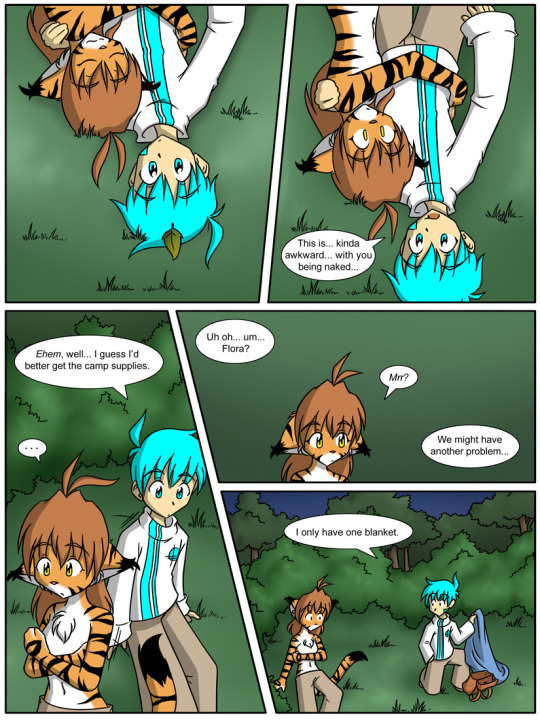
Furries!
Because furries really wanted furry content, and they were willing to pay for it. Pay a lot for it. Furry cheesecake comics prospered, and even though they didn’t have mainstream success, they were pulling it the big bucks compared to your average video game comic. People were starting to realize that 1000 hardcore fans was better than 100,000 casual fans, and a lot of comics started searching for a niche. (This is kind of related to webcomics becoming more progressive/inclusive a bit later, but that’s a whole ‘nother essay that I’m not the one to write)
These webcomics were pretty tame PG-13 stuff like you’d see in the shounen manga its creators were fans of, with nary a nipple to be seen, and a lot of them would die out in favor of straight-up porn.
In the late 2000s, art students realized that making a webcomic was a great way to build a portfolio, and we were hit with the Great Boom Of Webcomics By People Who Can Actually Draw. In 2003, that TwoKinds art was not only acceptable, it was top-tier for a free comic

By 2006 it was not the top tier

By 2008 it was no longer acceptable.
The world of webcomics became flooded with high-quality work by actual artists who’d gone to school and everything. The first generation of webcomics creators no longer ruled as the comics everyone read. Doctor Fun, the first-ever webcomic, ended in 2006. So did Narbonic and Mac Hall. Applegeeks, one of the most successful PA clones, ended in 2010 alongside 8-Bit Theater. Ctrl+Alt+Delete ended and rebooted to the interest of no one.
While in 2001, a bad artist could build a following just by updating regularly and slowly improving, that became a lot harder to do as the Bush Administration ended. There were too many brilliant artists making great content for someone to break onto the scene with simple art or sprites. And one day a lot of people gave up on ever being able to make a successful webcomic if their panels didn’t look like a magic the gathering card.
And it just so happened that that day, the 13th of April 2009, was a young man’s birthday…
43K notes
·
View notes
Text



Hanging with 6 year olds is REALLY funny
63K notes
·
View notes
Text
You can play Doom in this NY Times article about how you can run Doom almost anywhere (in a PDF, on an iPod, on a pregnancy test, on a treadmill, etc.) “Doom was developed in a really unique way that lent a high degree of portability to its code base.”
91 notes
·
View notes
Text
Was about to spend $25 on lipstick but the company's website said they donate to Preborn so I gave the money to my local abortion fund to balance things out instead.
0 notes
